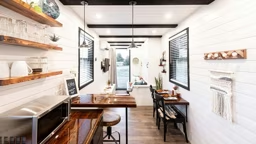
Most people don’t immediately associate cabin life with accessibility. Cabins are usually in rural, wooded areas and are often relatively secluded from centralized stores, restaurants or even medical care.
However, there’s no reason you can’t enjoy cabin life with safety, freedom and flexibility. Whether you deal with mobility problems or other age-related issues, one of the best things you can do is to build accessibility features into your cabin. While you might not be able to change the location — and likely don’t want to — there are things you can do to live in and access your cabin with ease.
Let’s look at a few of the most practical accessibility features you should install to ensure safety. The more accessible you make your cabin, the more comfortable you’ll be so you can enjoy the slow, relaxing pace of rural living.
Choosing the Right Location
If you’re currently in the market for a cabin or you want to build one from the ground up, consider the location before you make your final decision. There’s nothing wrong with wanting to live in a more rural area, but if you struggle with mobility or have underlying health issues, those matters need to be prioritized.
If you’re the family member of an aging individual with accessibility needs, encourage them to live close to you. Relocating aging parents doesn’t have to be stressful for anyone. Ask yourself what would be best for their lifestyle and their health needs and consider talking to them about their lifestyle. There are plenty of factors that should go into a relocation decision, so ask yourself questions like:
- Do they have pets?
- Do they have hobbies that require them to be near certain places?
- What is their monthly budget?
- Do they need access to public transportation?
- Do they need to be closer to a healthcare provider?
Sometimes, relocating away from cabin life is the best thing for someone as they get older and need help. However, if you’re still feeling good and your family is around to help and support you, do what you can to choose a cabin that allows you to be close to them. You’ll never regret having people who love you around to provide extra care when it’s needed.
Which Accessibility Features Do You Need?
Accessibility features need to be both functional and practical. While you’re considering what improvements to make, think about your needs and what might be required for you to age gracefully and safely in the comfort of your home. If you have mobility issues, things like wheelchair ramps and shower bars can make a big difference. Even some national park cabins have wheelchair ramps for guests. They’re easy to install and can make a world of difference when it comes to entering your home.
Some changes can be smaller, but just as important. If you use a wheelchair, cane or walker, the last thing you want is to get “stuck” somewhere, or trip over something in your home that might cause you to fall. Try to avoid putting down rugs that will easily slide or fold over, and make sure to focus on an interior design without too much clutter.
If you have vision issues, accessibility via indoor navigation is just as important. You should have walking paths inside and outside of the home. If you have stairs in your cabin, make sure they’re equipped with:
- Adequate lighting
- Non-slip nosing
- Easy-grip handrails
It’s also important to be able to see outdoors, especially if you live in a wooded or rural area. Install flood lights around your home or use solar-powered lights to guide a path from your door to your car, so you don’t have to worry about tripping on anything in the dark.
Preparing for the Future
In addition to preparing your home for common accessibility issues that come with age, you must keep seasonal preparations in mind. What you need to be comfortable in the summer might not be good enough by the time winter rolls around. It can be extremely dangerous to be “trapped” or not have your needs met because of weather or seasonal changes.
If you plan on staying in your cabin year-round, it’s essential to prep before cold weather hits. If you’re not able to secure your cabin for the winter on your own, ask a family member or hire someone to help with things like weather stripping, HVAC maintenance and putting together an emergency kit. Depending on where you live, winter can often make it difficult to get out of the house often. It’s imperative to have the supplies you need, including any medications or equipment needed to keep you healthy and comfortable. Cabin living requires consistent preparation and thinking ahead.
It’s normal to want to age in place with a modified home, and cabin living is a fantastic way to relax and enjoy yourself while surrounded by nature. However, don’t deny the potential accessibility issues that often come with age. Keep these tips in mind to build accessibility features into your cabin, create a design that works for you, and keep yourself comfortable while giving your family peace of mind.
Sam Bowman writes about people, tech, wellness, and how they merge. He enjoys getting to utilize the internet for the community without actually having to leave his house. In his spare time, he likes running, reading, and combining the two in a run to his local bookstore.










